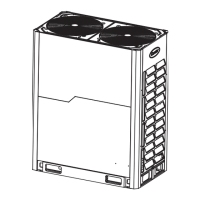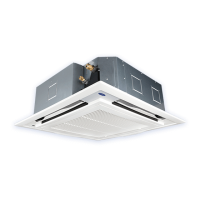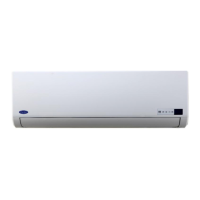16
Installation manual
The upstream of G1 is the two parallel connected outdoor units.
Refer to Tab.5-8 to select the three parallel connected outdoor
units. The pipe diameter isΦ38.1/Φ19.1.
Parallel connect the three outdoor units. Refer to Tab.5-8 to select
BJC-03-CM(i) for outdoor unit connective pipes (L+M).
2)
3)
Parallel connect the outdoor units
The outdoor unit linked by Pipe g1 is 12HP, which parallel
connects with the outdoor unit. Refer to Tab.5-8 the connective
pipe g1 diameter is Φ25.4/Φ12.7.
The outdoor unit linked by Pipe g2 is 12HP, which parallel
connects with the outdoor unit. Refer to Tab.5-8 the connective
pipe g2 diameter is Φ25.4/Φ12.7.
The outdoor unit linked by Pipe g3 is 22HP, which parallel
connects with the outdoor unit. Refer to Tab.5-8 the connective
pipe g3 diameter is Φ31.8/Φ15.9.
D
1)
CAUTION
Use the vacuum pump. The vacuum level needs to be lower
than -0.1MPa and the air discharge capacity above 4L/S.
There is no need to create a vacuum in the outdoor unit, so
do not open the outdoor unit gas and liquid pipe shut-off
valves.
Ensure the vacuum pump’s is -0.1 MPa or below after it has
ran for 2 hrs or more. If it runs for more than 3 hrs and cannot
get to -0.1MPa or below, check whether water has mixed or
gas has leaked inside the pipe.
5.10 Vacuum with vacuum pump
1)
2)
3)
Fig.5-4
5.8 Remove dirt or water from the pipe
Ensure there is no dirt or water before connecting the piping to
the outdoor units.
Wash the piping with high pressure nitrogen. Do not use the
refrigerant of the outdoor unit.
5.9 Gas tight test
When setting up the indoor unit pipeline, connect the
high-pressure pipe to the shut-off valve first.
Weld the pipe at the low-pressure side of the meter connector.
Use the vacuum pump for discharging air inside the liquid
side of the shut-off valve and meter connecter until it reaches
-1 kgf/cm
2
.
Close the vacuum pump and charge 40 kgf/cm2 of nitrogen gas
from the piston of the shut-off valve and meter connector. The
pressure inside should be maintained for no less than 24 hrs.
During the airtight test, weld the float valve and pipe at the
low-pressure side.
Pressurized nitrogen(3.9MPa;40 kgf/cm
2
)is used for
the airtight test.
Do not bring pressure into the float valve directly.
(See Fig. 5-5)
Do not use oxygen, combustible gas, or toxic gas to
conduct the airtight test.
When welding, use a wet cloth to insulate the two shut-off
valves for protection.
Avoid equipment damage by not maintaining the pressure
for too long.
●
●
●
●
●
1)
2)
3)
4)
5)
Fig.5-5
Outdoor unit
Indoor unit
Nitrogen
Liquid pipe
Gas pipe
Liquid side of
shut-off valve
Gas side of shut-off valve
N1
(140)
N4
(140)
N7
(140)
N8
(140)
N10
(28)
N12
(56)
N11
(140)
N3
(71)
N6
(28)
N13
(56)
A
B
G
H
K
I
L
C
E
L1
L2
L3
L5
L7
L8
L11
L12
L9
a
c
d
f
g h
j
l
m
k
M
L
g1 g2 g3
G1
W3
(12)
W2
(12)
W1
(22)
D
N
2
(140)
b
L4
N5
(140)
F
L6
e
N
9
(71)
i
J
L10

